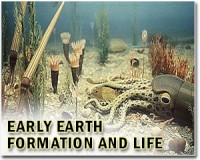| . |  |
. |
New Haven, Conn. (UPI) Jan 31, 2011 An ancestor to the horned dinosaur Triceratops reigned long before its well-known descendant, making it the earliest member of the family, U.S. researchers say. Paleontologists at Yale University said the new species, dubbed Titanoceratops after the Greek myth of the Titans, rivaled Triceratops in size with an estimated weight of nearly 15,000 pounds and a massive 8-foot-long skull, a university release reported Monday. Living in the American Southwest about 74 million years ago, Titanoceratops is the earliest known triceratopsin horned dinosaur, suggesting the group evolved into its large size more than 5 million years earlier than previously thought, paleontologist Nicholas Longrich says. Longrich was searching scientific papers when he saw a description of a partial skeleton of a dinosaur discovered in New Mexico in 1941 which went untouched until 1995 when it was identified incorrectly as Pentaceratops, a species similar to Triceratops common to the area. "When I looked at the skeleton more closely, I realized it was just too different from the other known Pentaceratops to be a member of the species," Longrich said. The newly identified Titanoceratops is very similar to Triceratops, but with a longer nose and slightly bigger horns, Longrich says. Longrich says he hopes paleontologists will find other fossil skeletons that would help confirm the differences between Titanoceratops and its descendants. "There have got to be more of them out there," Longrich said.
Share This Article With Planet Earth
Related Links Explore The Early Earth at TerraDaily.com
 Fossil casts doubt on dinosaur extinction
Fossil casts doubt on dinosaur extinctionCalgary, Alberta (UPI) Jan 27, 2011 Canadian researchers say a fossil found in New Mexico contradicts a long-held belief that dinosaurs went extinct abruptly 65.5 million to 66 million years ago. University of Alberta scientists determined an unearthed femur bone of a hadrosaur is only 64.8 million years old, indicating the plant-eating dinosaur was alive at least 700,000 years after the mass extinction event many paleont ... read more |
|
| The content herein, unless otherwise known to be public domain, are Copyright 1995-2010 - SpaceDaily. AFP and UPI Wire Stories are copyright Agence France-Presse and United Press International. ESA Portal Reports are copyright European Space Agency. All NASA sourced material is public domain. Additional copyrights may apply in whole or part to other bona fide parties. Advertising does not imply endorsement,agreement or approval of any opinions, statements or information provided by SpaceDaily on any Web page published or hosted by SpaceDaily. Privacy Statement |